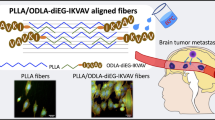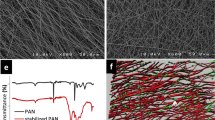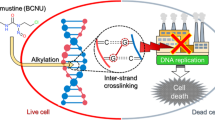Abstract
Glioblastoma multiforme is an aggressive, invasive brain tumour with a poor survival rate. Available treatments are ineffective and some tumours remain inoperable because of their size or location. The tumours are known to invade and migrate along white matter tracts and blood vessels. Here, we exploit this characteristic of glioblastoma multiforme by engineering aligned polycaprolactone (PCL)-based nanofibres for tumour cells to invade and, hence, guide cells away from the primary tumour site to an extracortical location. This extracortial sink is a cyclopamine drug-conjugated, collagen-based hydrogel. When aligned PCL-nanofibre films in a PCL/polyurethane carrier conduit were inserted in the vicinity of an intracortical human U87MG glioblastoma xenograft, a significant number of human glioblastoma cells migrated along the aligned nanofibre films and underwent apoptosis in the extracortical hydrogel. Tumour volume in the brain was significantly lower following insertion of aligned nanofibre implants compared with the application of smooth fibres or no implants.
This is a preview of subscription content, access via your institution
Access options
Subscribe to this journal
Receive 12 print issues and online access
$259.00 per year
only $21.58 per issue
Buy this article
- Purchase on Springer Link
- Instant access to full article PDF
Prices may be subject to local taxes which are calculated during checkout






Similar content being viewed by others
References
Davis, F. G., Freels, S., Grutsch, J., Barlas, S. & Brem, S. Survival rates in patients with primary malignant brain tumors stratified by patient age and tumor histological type: an analysis based on Surveillance, Epidemiology, and End Results (SEER) data, 1973–1991. J. Neurosurg. 88, 1–10 (1998).
Wiesner, S. M., Freese, A. & Ohlfest, J. R. Emerging concepts in glioma biology: implications for clinical protocols and rational treatment strategies. Neurosurg. Focus 19, E3 (2005).
Tuettenberg, J. et al. Recurrence pattern in glioblastoma multiforme patients treated with anti-angiogenic chemotherapy. J. Cancer Res. Clin. Oncol. 135, 1239–1244 (2009).
Rostomily, R. C. et al. Multimodality management of recurrent adult malignant gliomas: results of a phase II multiagent chemotherapy study and analysis of cytoreductive surgery. Neurosurgery 35, 378–388 (1994).
Bar, E. E. et al. Cyclopamine-mediated hedgehog pathway inhibition depletes stem-like cancer cells in glioblastoma. Stem Cells 25, 2524–2533 (2007).
Bellail, A. C., Hunter, S. B., Brat, D. J., Tan, C. & Van Meir, E. G. Microregional extracellular matrix heterogeneity in brain modulates glioma cell invasion. Int. J. Biochem. Cell Biol. 36, 1046–1069 (2004).
Bernstein, J. J. & Woodard, C. A. Glioblastoma cells do not intravasate into blood vessels. Neurosurgery 36, 124–132 (1995).
Weiner, H. L. et al. Induction of medulloblastomas in mice by sonic hedgehog, independent of Gli1. Cancer Res. 62, 6385–6389 (2002).
Becher, O. J. et al. Gli activity correlates with tumor grade in platelet-derived growth factor-induced gliomas. Cancer Res. 68, 2241–2249 (2008).
Grossman, S. A. et al. The intracerebral distribution of BCNU delivered by surgically implanted biodegradable polymers. J. Neurosurg. 76, 640–647 (1992).
Kohn, K. W. Interstrand cross-linking of DNA by 1,3-bis(2-chloroethyl)-1-nitrosourea and other 1-(2-haloethyl)-1-nitrosoureas. Cancer Res. 37, 1450–1454 (1977).
Kee, N., Sivalingam, S., Boonstra, R. & Wojtowicz, J. M. The utility of Ki-67 and BrdU as proliferative markers of adult neurogenesis. J. Neurosci. Methods 115, 97–105 (2002).
Haghparast, S. M. A., Kihara, T., Shimizu, Y., Yuba, S. & Miyake, J. Actin-based biomechanical features of suspended normal and cancer cells. J. Biosci. Bioeng. 116, 380–385 (2013).
Biran, R., Noble, M. D. & Tresco, P. A. Directed nerve outgrowth is enhanced by engineered glial substrates. Exp. Neurol. 184, 141–152 (2003).
Kanda, S. et al. Sonic hedgehog induces capillary morphogenesis by endothelial cells through phosphoinositide 3-kinase. J. Biol. Chem. 278, 8244–8249 (2003).
Baluk, P., Morikawa, S., Haskell, A., Mancuso, M. & McDonald, D. M. Abnormalities of basement membrane on blood vessels and endothelial sprouts in tumors. Am. J. Pathol. 163, 1801–1815 (2003).
Hernandez, L., Smirnova, T., Wyckoff, J., Condeelis, J. & Segall, J. E. In vivo assay for tumor cell invasion. Methods Mol. Biol. 571, 227–238 (2009).
Wyckoff, J., Gligoijevic, B., Entenberg, D., Segall, J. E. & Condeelis, J. The in vivo invasion assay: preparation and handling of collection needles. Cold Spring Harbor Protocols 10, 1232–1234 (2011).
Kim, Y. T., Haftel, V. K., Kumar, S. & Bellamkonda, R. V. The role of aligned polymer fiber-based constructs in the bridging of long peripheral nerve gaps. Biomaterials 29, 3117–3127 (2008).
Karumbaiah, L. et al. The upregulation of specific interleukin (IL) receptor antagonists and paradoxical enhancement of neuronal apoptosis due to electrode induced strain and brain micromotion. Biomaterials 33, 5983–5996 (2012).
Acknowledgements
We would like to thank J. Leisen for his technical expertise with the MR scanner and J. Lyon and S. Nayebosadri for their assistance with the animal surgeries and immunohistochemistry. We would also like to acknowledge funding support for this project from National Institutes of Health EUREKA R01 CA153229 (NCI) (R.V.B.), the Georgia Research Alliance (R.V.B.), and Ian’s Friends Foundation (R.V.B.)
Author information
Authors and Affiliations
Contributions
R.V.B. conceived the tumour ‘exvasion’ strategy using nanofibre films towards an apoptosis-inducing hydrogel and was responsible for the overall study design. A.J. implemented the above strategy by means of the design of a nanofibre tumour guide and a hydrogel sink, and also performed the surgeries, designed the experiments and analysed the results. M.B. oversaw the smooth film control studies, as well as quantified the Ki-67+ staining and tumour volume. G.D.P. fabricated the polymer conduits and nanofibre films. C.M.V. designed and performed the collagen and cyclopamine collagen two-well depot Live/Dead experiments, based on a cyclopamine strategy suggested by T.J.M. V.J.M. assisted with animal surgeries and tissue sectioning. A.V. performed haematoxylin and eosin staining and helped with histological assessment. S.B.P. stably transfected the U87MG cells to express eGFP. B.B helped with surgical strategy.
Corresponding author
Ethics declarations
Competing interests
The authors declare no competing financial interests.
Supplementary information
Supplementary Information
Supplementary Information (PDF 1363 kb)
Rights and permissions
About this article
Cite this article
Jain, A., Betancur, M., Patel, G. et al. Guiding intracortical brain tumour cells to an extracortical cytotoxic hydrogel using aligned polymeric nanofibres. Nature Mater 13, 308–316 (2014). https://doi.org/10.1038/nmat3878
Received:
Accepted:
Published:
Issue Date:
DOI: https://doi.org/10.1038/nmat3878
This article is cited by
-
Recent advancements of electrospun nanofibers for cancer therapy
Polymer Bulletin (2023)
-
Conformable hierarchically engineered polymeric micromeshes enabling combinatorial therapies in brain tumours
Nature Nanotechnology (2021)
-
Functional regeneration and repair of tendons using biomimetic scaffolds loaded with recombinant periostin
Nature Communications (2021)
-
Mimicking tumor hypoxia and tumor-immune interactions employing three-dimensional in vitro models
Journal of Experimental & Clinical Cancer Research (2020)
-
Engineered hydrogels for brain tumor culture and therapy
Bio-Design and Manufacturing (2020)



